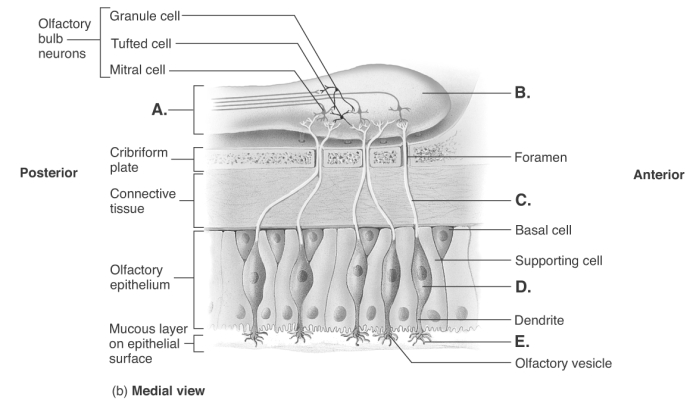A) stimulate mitral cells
B) release acetylcholine
C) cause proliferation of basal cells
D) bind to receptor molecules on the olfactory hair membrane
E) lower the threshold of the cell
Correct Answer

verified
Correct Answer
verified
Multiple Choice
Which of the following definitions best describes the timbre of sounds?
A) loudness
B) amplitude
C) wave frequency
D) resonance quality
E) pitch
Correct Answer

verified
Correct Answer
verified
Multiple Choice
Why does inhaling deeply and slowly through the nose help to identify an odor?
A) More air containing the odor is brought into contact with the olfactory epithelium.
B) Impulses originate slowly in the olfactory epithelium.
C) The tissue needs more time in contact with the odor.
D) Threshold for odor detection is high.
E) Receptors in the olfactory epithelium are highly specific.
Correct Answer

verified
Correct Answer
verified
Multiple Choice
Which of the following cranial nerves innervates an eye muscle?
A) optic
B) facial
C) abducens
D) trigeminal
E) vagus
Correct Answer

verified
Correct Answer
verified
Multiple Choice
Match the description with the most appropriate structure. -oval window
A) structures that produce earwax
B) fluid in the membranous labyrinth
C) fluid between the membranous and bony labyrinth
D) ossicles connect this structure to eardrum
E) connects the middle ear to the pharynx
Correct Answer

verified
Correct Answer
verified
Multiple Choice
Match the structure with the appropriate description. -visual field
A) the area that can be seen with the eyes open
B) opening in the orbit through which the optic nerve passes
C) the cerebral area that integrates messages from retina
D) area where medial ganglion cell axons cross over
E) the route of the ganglionic axons beyond the chiasma
Correct Answer

verified
Correct Answer
verified
Multiple Choice
The transparent anterior portion of the sclera is the
A) iris.
B) retina.
C) cornea.
D) choroid.
E) pupil.
Correct Answer

verified
Correct Answer
verified
Multiple Choice
Match the description with its correct name. -astigmatism
A) difficulty seeing distant objects
B) a type of refractory error
C) clouding of the lens of the eye
D) increased intraocular pressure that can lead to loss of vision
E) loss of acute central vision
Correct Answer

verified
Correct Answer
verified
Multiple Choice
Match the structure with the appropriate description. -eyebrows
A) lubricate the eyelid
B) protect the eye from falling objects
C) an inflamed ciliary gland
D) small tubes that drain tears into the lacrimal sac
E) inflammation of the conjunctiva
Correct Answer

verified
Correct Answer
verified
Multiple Choice
Which of the following is true?
A) The cochlear duct is filled with perilymph.
B) The bony core of the cochlea is called the modiolus.
C) The foot plate of the incus fits into the round window.
D) The vestibule is one of the regions of the organ of corti.
E) The spiral organ is found in the semicircular canals.
Correct Answer

verified
Correct Answer
verified
Multiple Choice
Match the structure with the appropriate description. -auditory ossicles
A) organ of hearing
B) passageway from the outside to the eardrum
C) interconnecting tunnels in the temporal bone
D) tiny bones in the middle ear
E) connecting chambers of inner ear filled with endolymph
Correct Answer

verified
Correct Answer
verified
Multiple Choice
An inflammation of one of the ciliary glands of the eyelashes is called a
A) sty.
B) boil.
C) chalazion.
D) meibomian cyst.
E) pinkeye.
Correct Answer

verified
Correct Answer
verified
Multiple Choice
The attenuation reflex
A) amplifies loud noises.
B) enhances low frequency sounds.
C) prevents damage to delicate ear structures.
D) involves the scala vestibuli and the scala tympani.
E) vibrates the tympanic membrane.
Correct Answer

verified
Correct Answer
verified
Multiple Choice
Cochlear neurons are stimulated by
A) vibrating the oval window.
B) vibrations of the tectorial membrane.
C) bending microvilli or stereocilia on the hair cells.
D) movement of the otoliths in the endolymph.
E) turning the spiral organ.
Correct Answer

verified
Correct Answer
verified
Multiple Choice
Which of the following is part of the spiral organ (organ of Corti) ?
A) modiolus
B) vestibule
C) tectorial membrane
D) scala tympani
E) chorda tympani
Correct Answer

verified
Correct Answer
verified
Multiple Choice
Match the structure with the appropriate description. -inner ear
A) eardrum
B) part of the ear that contains the organ of hearing
C) the pinna and external auditory meatus are part of this
D) fleshy portion of the external ear
E) air-filled space within the temporal bone
Correct Answer

verified
Correct Answer
verified
Multiple Choice
 -Olfaction is the sense of smell. What does "D" represent?
-Olfaction is the sense of smell. What does "D" represent?
A) olfactory bulb
B) cilia (olfactory hairs)
C) olfactory neuron
D) axon of olfactory neuron
E) olfactory tract
Correct Answer

verified
Correct Answer
verified
Multiple Choice
Some thyroid disorders are characterized by an increase in the width of the palpebral fissure. This would be an increase in the distance between the
A) eyebrows.
B) eyelashes.
C) eyelids.
D) eyes.
E) lacrimal glands.
Correct Answer

verified
Correct Answer
verified
Multiple Choice
Match the structure with the appropriate description. -olfactory tract
A) relay olfactory information to the brain and synapse with association neurons in the olfactory bulb
B) area of the brain where the olfactory tracts terminate
C) enlargements on the dendrites of olfactory neurons
D) fibers that connect the olfactory bulb to the cortex
E) the expanded anterior portions of the olfactory nerves
Correct Answer

verified
Correct Answer
verified
Multiple Choice
Match the description with the most appropriate structure. -perilymph
A) structures that produce earwax
B) fluid in the membranous labyrinth
C) fluid between the membranous and bony labyrinth
D) ossicles connect this structure to eardrum
E) connects the middle ear to the pharynx
Correct Answer

verified
Correct Answer
verified
Showing 41 - 60 of 195
Related Exams